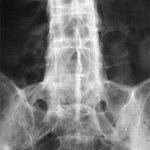NEW YORK (Reuters Health)—Guselkumab may be effective in patients who have psoriatic arthritis (PsA) with axial symptoms, a post-hoc analysis of data from two randomized controlled trials suggests.1
“Because PsA is a heterogeneous disease that manifests as various symptoms, treatment choices should involve consideration of all relevant domains of disease for each individual patient,” researchers write in The Lancet Rheumatology. “This post-hoc analysis suggests that therapies inhibiting the IL-23 p19 subunit might be effective in addressing axial symptoms in patients with psoriatic arthritis.”
The DISCOVER-1 and DISCOVER-2 studies enrolled over 1,100 patients worldwide who had active PsA with swollen joints. Patients were randomly allocated to receive 100 mg of guselkumab every four weeks, 100 mg of guselkumab every eight weeks or placebo. In those studies, guselkumab-treated patients showed greater improvements in PsA signs and symptoms compared with patients treated with placebo.
In the new pooled analysis, Philip Mease, MD, of Swedish Medical Center, Seattle, and colleagues examined the effects of guselkumab in trial participants who had axial symptoms and sacroiliitis before enrollment or at screening. They included 103 who received guselkumab every four weeks, 91 who received guselkumab every eight weeks and 118 patients took placebo.
Of the 190 patients with available HLA-B27 status data, 30% were HLA-B27-positive and 70% were HLA-B27-negative. At week 24, least-squares mean changes from baseline in Bath Ankylosing Spondylitis Disease Activity Index (BASDAI) were -2.7 in both guselkumab groups and -1.3 in those taking placebo, both significant differences; modified BASDAI (mBASDAI) and spinal pain results showed a similar pattern.
Also at week 24, least-squares mean changes in Ankylosing Spondylitis Disease Activity Score (ASDAS) scores were -1.4 in both guselkumab dosage groups and -0.7 in those taking placebo.
At week 24, 38% of patients taking guselkumab every four weeks and 40% of those taking guselkumab every eight weeks improved their score by at least 50% compared with 19% in the placebo group (P=0.004 and P=0.005, respectively).
Both HLA-B27-positive and HLA-B27-negative patients who were taking guselkumab improved at week 24 and maintained improvements at week 52.
“The fact that significant improvements in measures of symptoms of spine disease, in this group of patients that investigators considered to have axial PsA and had imaging evidence of sacroiliitis, and objective marker of axial PsA, raises the notion that axial PsA may be immunobiologically distinct enough from ankylosing spondylitis that the assumptions about therapeutic response to a mechanism like IL-23 do not hold,” Dr. Mease tells Reuters Health by email.



